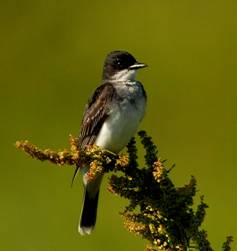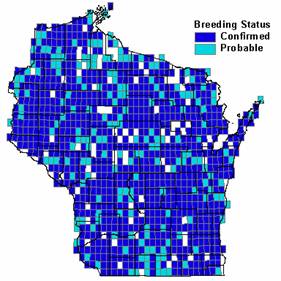

Status/Protection
- Global Rank: G5 Key to global and state ranks
- State Rank: S5
- WBCI Priority: None
Population Information
The Federal BBS information can be obtained at http://www.mbr-pwrc.usgs.gov/bbs/bbs.html by clicking on Trend Estimates and selecting the species in question. All estimates are for time period (1966-2005).
- Federal Breeding Bird Survey: significant decline
- Federal Breeding Bird Survey (WI): significant decline
- Federal Breeding Bird Survey (BCR 23): significant decline
- Federal Breeding Bird Survey (BCR 12): significant decline
- Chequamegon National Forest Bird Survey (NRRI): non-significant increase (1992-2005)
- WSO Checklist Project: significant decline (1983-2007)
Life History
- Breeding Habitat: Pine Barrens, Sand Barrens, Oak Opening, Grassland-shrub, any grassland type with shrubs or scattered trees, Jack Pine or Red Pine cutovers
- Nest: See Birder’s Handbook
- Nesting Dates: late May-early June
- Foraging: See Birder’s Handbook
- Migrant Status: Early, long-distance migrant
- Habitat use during Migration: farmsteads, all carr
- Arrival Dates: Late April to early June
- Departure Dates: Early August to late September
- Winter Range: South America
- Winter Habitat: River and lake edges as well as tropical forest canopy (Murphy 1996)
Habitat Selection
Eastern Kingbirds are habitat generalists and will nest in most open, shrubby habitats in both uplands and wetlands. Nests are known to be built on stumps and in oak, apple, jack pine, black ash, alder and willow trees/shrubs (Robbins 1991). Eastern Kingbirds nest in shrubs and trees and therefore require that at least some woody plants are present for nesting.
Habitat Availability
Eastern Kingbirds are known to nest in every Wisconsin county and have been recorded on every Breeding Bird Survey (BBS) transect in the state (Robbins 1991). This indicates that Eastern Kingbirds habitat if not abundant, is certainly widespread.
Population Concerns
BBS data indicate marked declines in Eastern Kingbird populations. Factors contributing to this decline must also be widespread. If the species’ decline is related to nesting habitat in North America, the loss of fallow fields, grasslands and other open areas to succession and the loss of natural disturbance regimes are likely contributing to the species’ decline. Losses of pasture, hay and grass-based agriculture, shelterbelts, small farms and forest succession have probably all contributed to declines (Murphy 1996). Researchers have also noted hatching failures in regions and habitats with heavy pesticide usage (Murphy 1996) which may be limiting populations.
Recommended Management
Any management designed to maintain open areas with a shrub and tree component will benefit Eastern Kingbirds. These activities include but are not limited to: prescribed burning, mowing, and herbiciding. Efforts to restore grasslands, savannas and barrens will most certainly benefit this species. In addition, small dairy or organic farming operations that maintain patches of shrubs or trees next to crop fields might also be beneficial.
Research Needs
Determine whether species that commonly nest in and around agricultural fields are impacted by pesticides.
Information Sources
- David Sample, Grassland Community Ecologist, Wisconsin DNR Research Center, 1350 Femrite Dr., Monona, WI 53716.
- North American Breeding Bird Survey: http://www.npwrc.usgs.gov
- Wisconsin Breeding Bird Atlas: http://www.uwgb.edu/birds/wbba/
References
- Murphy, M.T. 1996. Eastern Kingbird (Tyrannus tyrannus). In The Birds of North America, No 253 (A.Poole and F. Gill, eds.). The Academy of Natural Sciences, Philadelphia, PA, and the American Ornithologists’ Union, Washington, D.C.
- Robbins, S. D., Jr. 1991. Wisconsin Birdlife: Population and distribution past and present. Madison, WI: Univ. Wisconsin Press.
- Sample, D. and M. Mossman. 1997. Managing Habitat for Grassland Birds: A Guide for Wisconsin. Wisconsin Department of Natural Resources: Madison, WI.
Contact Information
- Compiler: Jenny Herrmann, Wisconsin DNR, 262-574-2173
- Editor: Richard King, Richard_s_king@fws.gov
